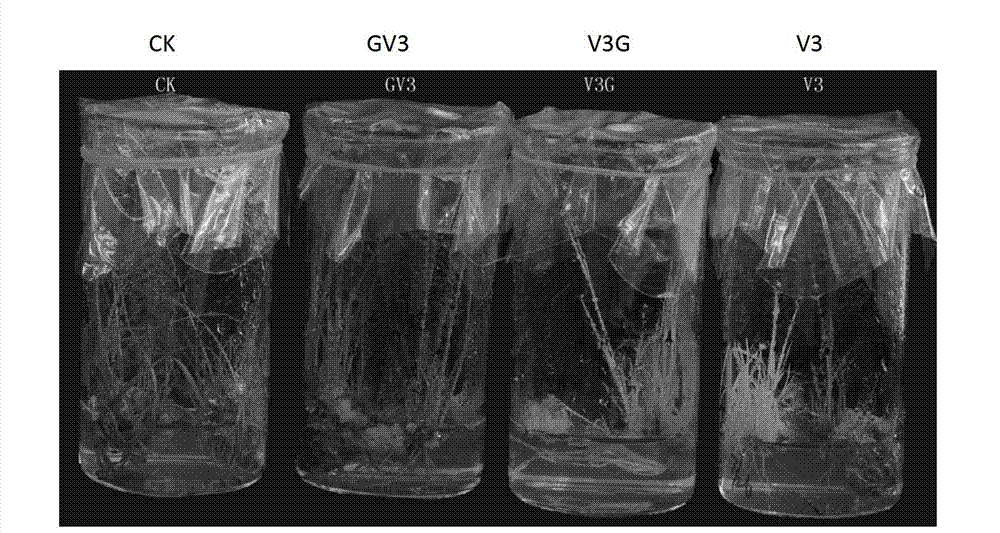Method for reducing toxicity of Vip3 protein to transgenic plant through gene fusion
A technology of transgenic plants and gene fusion, which is applied in the application field of constructing Vip3 protein fusion genes and constructing insect-resistant transgenic plants, can solve the problems of easy occurrence of albino, slow growth of transgenic plants, and low insect resistance of transgenic plants, and achieves good The effect of anti-insect activity
- Summary
- Abstract
- Description
- Claims
- Application Information
AI Technical Summary
Problems solved by technology
Method used
Image
Examples
Embodiment 1
[0057] Embodiment 1, the acquisition of fusion gene
[0058] SEQ ID NO: 1 is the amino acid sequence of Vip3 (789aa) Genebank: ABB72459.1; SEQ ID NO: 2 is the amino acid sequence of GFP (241aa) Genebank: AFA52654.1.
[0059] According to the nucleotide sequences corresponding to the amino acid sequences of SEQ ID NO: 1 and SEQ ID NO: 2, vip3 and egfp (encoding GFP protein) genes were synthesized by themselves (Shanghai Shengong).
[0060] The egfp-vip3 fusion gene was obtained by gene splicing by overlap extension (SOE) method. details as follows:
[0061] First, the first round of PCR uses the synthetic egfp gene plasmid as a template, using primers egfpPF1: 5’-acg aagctt atgtctagagtgagcaag (plus HindIII) and egfpPR1: 5’- tgttggatctcc cttgtacagctcgtcc amplifies the egfp gene; meanwhile, using the synthetic vip3 gene plasmid as a template, primer Vip3PF1:5'- ggagatccaaca atgaacaagaataatac and Vip3PR1: 5'-acg ggtacc ctacttaatagagac (plus KpnI) amplifies the vip3 gene. Amo...
Embodiment 2
[0075] Embodiment 2, the construction of the rice expression vector of fusion gene
[0076] The entire DNA sequence of the T-DNA vector pCambia1300-p35S-pZmUbi-G10 is shown in SEQ ID NO:5. The vector contains a glyphosate-resistant gene (EPSPS) as the selection gene for transformation, and a set of HindIII and KpnI sites as the cloning site of the target gene. After the fusion gene egfp-vip3 and pCambia1300-p35S-pZmUbi-G10 vectors were digested with HindIII and KpnI respectively, the target fragments were separated by gel electrophoresis, and the new vectors were obtained by ligating the vectors and fragments Called pCambia 1300-p35S-gfp-vip3-pZmUbi-G10. The schematic diagram of vector construction is shown in figure 1 shown.
[0077] Simultaneously, separate vip3 gene and vip3-egfp fusion gene vectors pCambia 1300-p35S-vip3-pZmUbi-G10 and pCambia 1300-p35S-vip3-gfp-pZmUbi-G10 were constructed as controls by the same method as above.
Embodiment 3
[0078] Embodiment 3, rice transformation mediated by Agrobacterium
[0079] The method of obtaining transgenic rice is to use the existing technology (Lu Xiongbin et al., 1998; Liu Fan et al., 2003). The mature and plump "Xiushui 134" seeds were dehulled, and callus was induced as transformation materials. Take the target gene vector pCambia1300-p35S-gfp-vip3-pZmUbi-G10 and pCambia1300-p35S-vip3-gfp-pZmUbi-G10, pCambia1300-p35S-vip3-pZmUbi-G10 and the empty vector pCambia1300-p35S-pZmUbi-G10 The Agrobacterium plate, pick a single colony inoculation ready for transformation with Agrobacterium. Put the callus to be transformed into the appropriate concentration of Agrobacterium solution (containing acetosyringone), let the Agrobacterium bind to the surface of the callus, then transfer the callus to the co-culture medium, and co-culture for 2 to 3 sky. Wash the transformed callus with sterile water, transfer to the selection medium containing 2mM glyphosate, and select and cul...
PUM
 Login to View More
Login to View More Abstract
Description
Claims
Application Information
 Login to View More
Login to View More - R&D
- Intellectual Property
- Life Sciences
- Materials
- Tech Scout
- Unparalleled Data Quality
- Higher Quality Content
- 60% Fewer Hallucinations
Browse by: Latest US Patents, China's latest patents, Technical Efficacy Thesaurus, Application Domain, Technology Topic, Popular Technical Reports.
© 2025 PatSnap. All rights reserved.Legal|Privacy policy|Modern Slavery Act Transparency Statement|Sitemap|About US| Contact US: help@patsnap.com



